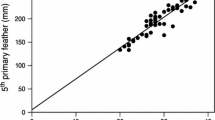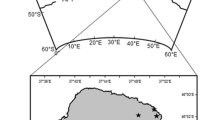Abstract
Stable isotope analysis of carbon and nitrogen is frequently used to study the diets and foraging ecology of marine predators. However, isotopic values may also be affected by an individual’s nutritional status and associated physiological processes. Here, we use C and N stable isotopes in blood and feathers of blue-footed booby chicks at the Galápagos Islands to examine how isotopic values are related to body condition and growth rate, and to assess the consistency in the isotope ratios of individuals during growth. Size dimorphism in blue-footed boobies provided an additional opportunity to examine how isotope ratios differ between sexes in relation to body size and growth rate. There was no significant difference between sexes but both C and N stable isotopes were significantly negatively related to the body condition of chicks. These data were consistent with individual variation in physiological processes affecting fractionation, although we cannot rule out the possibility that they were also influenced to some extent by population-level variation in the stable isotope ratios of prey fed to chicks, for instance related to prey size, depth or lipid content. Our results highlight the need for methods that take proper account of confounding physiological factors in isotopic studies of foraging ecology and diet.




Similar content being viewed by others
References
Anderson DJ (1989) Differential responses of boobies and other seabirds in the Galápagos to the 1986–87 El Niño southern oscillation event. Mar Ecol Prog Ser 52:209–216
Au DWK, Pitman RL (1986) Seabird interactions with dolphins and tuna in the Eastern Tropical Pacific. Condor 88:304–317
Aurioles-Gamboa D, Newsome SD, Salazar-Pico S, Koch PL (2009) Stable isotope differences between sea lions (Zalophus) from the Gulf of California and Galápagos Islands. J Mammal 90:1410–1420
Bearhop S, Teece MA, Waldron S, Furness RW (2000) Influence of Lipid and Uric Acid on δ13C and δ15N values of avian blood: implications for trophic studies. Auk 117:504–507
Bearhop S, Waldron S, Votier SC, Furness RW (2002) Factors that influence assimilation rates and fractionation of nitrogen and carbon stable isotopes in avian blood and feathers. Physiol Biochem Zool 75:451–458
Bearhop S, Phillips RA, McGill RAR, Cherel Y, Dawson DA, Croxall JP (2006) Stable isotopes indicate sex-specific and long-term individual foraging specialisation in diving seabirds. Mar Ecol Prog Ser 311:157–164. doi:10.3354/meps311157
Bermúdez-Humarán LG, García-García A, Leal-Garza CH, Riojas-Valdes VM, Jaramillo-Rangel G, Montes-de-Oca-Luna R (2002) Molecular sexing of monomorphic endangered Ara birds. J Exp Zool 292:677–680
Bihn JH, Gebauer G, Brandl R (2010) Loss of functional diversity of ant assemblages in secondary tropical forests. Ecology 91:782–792. doi:10.1890/08-1276.1
Blüthgen N, Gebauer G, Fiedler K (2003) Disentangling a rainforest food web using stable isotopes: dietary diversity in a species-rich ant community. Oecologia 137:426–435
Bode A, Carrera P, Lens S (2003) The pelagic foodweb in the upwelling ecosystem of Galicia (NW Spain) during spring: natural abundance of stable carbon and nitrogen isotopes. ICES J Mar Sci 60:11–22
Burger AE, Shaffer SA (2008) Application of tracking and data-logging technology in research and conservation of seabirds. Auk 125:253–264
Catry T, Ramos JA, Le Corre M, Kojadinovic J, Bustamante P (2008) The role of stable isotopes and mercury concentrations to describe seabird foraging ecology in tropical environments. Mar Biol 155:637–647
Cherel Y, Hobson KA, Bailleul F, Groscolas R (2005a) Nutrition, physiology, and stable isotopes: new information from fasting and moulting penguins. Ecology 86:2881–2888
Cherel Y, Hobson KA, Hassani S (2005b) Isotopic discrimination between food and blood and feathers of captive penguins: implications for dietary studies in the wild. Phys Biochem Zool 78:106–115
Cherel Y, Kernaleguen L, Richard P, Guinet C (2009) Whisker isotopic signature depicts migration patterns and multi-year intra- and inter-individual foraging strategies in fur seals. Biol Lett 5:830–832
Drummond H, Osorno JL, Torres R, García-Chavelas C, Merchant Larios H (1991) Sexual size dimorphism and sibling competition: implications for avian sex ratios. Am Nat 138:623–641
Ehrich D, Tarroux A, Stien J, Lecompte N, Killengreen S, Berteaux D, Yoccoz NG (2010) Stable isotope analysis: modelling lipid normalization for muscle and eggs from arctic mammals and birds. Methods Ecol Evol 2:66–76
Forero MG, Hobson KA (2003) Using stable isotopes of nitrogen and carbon to study seabird ecology: applications in the Mediterranean seabird community. Sci Marina 67(Suppl 2):23–32
Forero MG, Tella K (2002) Conspecific food competition explains variability in colony size: a test in Magellanic penguins. Ecology 83:3466–3475
Forero MG, Hobson KA, Bortolotti GR, Donázar JA, Bertellotti M, Blanco G (2002) Food resource utilisation by the Magellanic penguin evaluated through stable-isotope analysis: segregation by sex and age and influence on offspring quality. Mar Ecol Prog Ser 234:289–299
Forero MG, González-Solís J, Hobson KA, Donázar JA, Bertellotti M, Blanco G, Bortolotti GR (2005) Stable isotopes reveal trophic segregation by sex and age in the southern giant petrel in two different food webs. Mar Ecol Prog Ser 296:107–113
Fridolfsson AK, Ellegren H (1999) A simple and universal method for molecular sexing of non-ratite birds. J Avian Biol 30:116–121
Gannes LZ, O’Brien DM, Martínez del Rio C (1997) Stable isotopes in animal ecology: assumptions, caveats, and a call for more laboratory experiments. Ecology 78:1271–1276. doi:10.1890/0012-9658
Hamer KC, Furness RW, Caldow RWG (1991) The effects of changes in food availability on the breeding ecology of Great Skuas Catharacta skua in Shetland. J Zool 223:175–188
Hobson KA, Clark RG (1992) Assessing avian diets using stable isotopes I: turnover of 13 C in tissues. Condor 94:181–188
Hobson KA, Alisauskas RT, Clark RG (1993) Stable-nitrogen isotope enrichment in avian tissues due to fasting and nutritional stress: implications for isotopic analyses of diet. Condor 95:388–394
Hobson KA, Piatt JF, Pitocchelli J (1994) Using stable isotopes to determine seabird trophic relationships. J Anim Ecol 63:786–798
Inger R, Bearhop S (2008) Applications of stable isotope analyses to avian ecology. Ibis 150:447–461
Kempster B, Zanette L, Longstaffe FJ, MacDougall-Shackleton SA, Wingfield JC, Clinchy M (2007) Do stable isotopes reflect nutritional stress? Results from a laboratory experiment on song sparrows. Oecologia 151:365–371
Layman CA, Winemiller KO, Arrington DA, Jepsen DB (2005) Body size and trophic position in a diverse tropical food web. Ecology 86:2530–2535
Magrath MJL, Van Lieshout E, Pen I, Visser GH, Komdeur J (2007) Estimating expenditure on male and female offspring in a sexually size-dimorphic bird: a comparison of different methods. J Anim Ecol 76:1169–1180
Martínez del Rio C, Wolf N, Carleton SA, Gannes LZ (2009) Isotopic ecology ten years after a call for more laboratory experiments. Biol Rev 84:91–111
Nelson JB (1978) The Sulidae: gannets and boobies. Oxford University Press, Oxford
Owen JC, Sogge MK, Kern MD (2005) Habitat and sex differences in physiological condition of breeding Southwestern willow flycatchers (Empidonax trailli extimus). Auk 122:1261–1270
Papastamatiou YP, Friedlander AM, Caselle JE, Lowe CG (2010) Long-term movement patterns and trophic ecology of blacktip reef sharks (Carcharhinus melanopterus) at Palmyra Atoll. J Exp Mar Biol Ecol 386:94–102
Pearson SF, Levey DJ, Greenberg CH, Martínez del Rio C (2003) Effects of elemental composition on the incorporation of dietary nitrogen and carbon isotopic signatures in an omnivorous songbird. Oecologia 135:516–523
Pecquerie L, Nisbet RM, Fablet R, Lorrain A, Kooijman SALM (2010) The impact of metabolism on stable isotope dynamics: a theoretical framework. Phil Trans R Soc B 365:3455–3468
Phillips D, Eldridge P (2006) Estimating the timing of diet shifts using stable isotopes. Oecologia 147:195–203
Phillips RA, Catry P, Silk JRD, Bearhop S, McGill RAR, Afanasyev V, Strange IJ (2007) Movements, winter distribution and activity patterns of Falkland and brown skuas: insights from loggers and isotopes. Mar Ecol Prog Ser 345:281–291. doi:10.3354/meps06991
Ponsard S, Averbuch P (1999) Should growing and adult animals fed on the same diet show different δ15N values? Rapid Commun Mass Spectrom 13:1305–1310
Post DM, Layman CA, Arrington DA, Takimoto G, Quattrochi J, Montaña CG (2007) Getting to the fat of the matter: models, methods and assumptions for dealing with lipids in stable isotope analysis. Oecologia 152:179–189
Quillfeldt P, Bugoni L, McGill RAR, Masello JF, Furness RW (2008a) Differences in stable isotopes in blood and feathers of seabirds are consistent across species, age and latitude: implications for food web studies. Mar Biol 155:593–598
Quillfeldt P, McGill RAR, Masello JF, Weiss F, Strange IJ, Brickle P, Furness RW (2008b) Stable isotope analysis reveals sexual and environmental variability and individual consistency in foraging of thin-billed prions. Mar Ecol Prog Ser 373:137–148. doi:10.3354/meps07751
Quillfeldt P, Masello JF, McGill RAR, Adams M, Furness RW (2010) Moving polewards in winter: a recent change in the migratory strategy of a pelagic seabird? Front Zool 7:15
R Development Core Team (2008) R: a language, environment for statistical computing. R Foundation for Statistical Computing, Vienna
Riou S, Hamer KC (2010) Lipid metabolism, begging behaviour and nestling obesity in a pelagic seabird. Funct Ecol 24:340–346
Sears J, Hatch SA, O’Brien DM (2009) Disentangling effects of growth and nutritional status on seabird stable isotope ratios. Oecologia 159:41–48
Sotiropoulos MA, Tonn WM, Wassenaar LI (2004) Effects of lipid extraction on stable carbon and nitrogen isotope analysis of fish tissues: potential consequences for food web studies. Ecol Freshw Fish 13:155–160
Torres R, Drummond H (1999) Does large size make daughters of the blue-footed booby more expensive than sons? J Anim Ecol 68:1133–1141
Trueman CN, McGill RAR, Guyard PH (2005) The effect of growth rate on tissue-diet isotopic spacing in rapidly growing animals. An experimental study with Atlantic salmon (Salmo salar). Rapid Commun Mass Spectrom 19:3239–3247
Velando A (2002) Experimental manipulation of maternal effort produces differential effects in sons and daughters: implications for adaptive sex ratios in the blue-footed booby. Behav Ecol 13:443–449
Votier SC, Bearhop S, Witt MJ, Inger R, Thompson D, Newton J (2010) Individual responses of seabirds to commercial fisheries revealed using GPS tracking, stable isotopes and vessel monitoring systems. J Appl Ecol 47:487–497
Weimerskirch H, Shaffer SA, Tremblay Y, Costa DP, Gadenne H, Kato A, Ropert-Coudert Y, Sato K, Aurioles D (2009) Species- and sex-specific differences in foraging behaviour and foraging zones in blue-footed and brown boobies in the Gulf of California. Mar Ecol Prog Ser 391:267–278
West JB, Bowen GJ, Cerling TE, Ehleringer JR (2006) Stable isotopes as one of nature’s ecological recorders. Trends Ecol Evol 21:408–414
Williams C, Buck C, Sears J, Kitaysky A (2007) Effects of nutritional restriction on nitrogen and carbon stable isotopes in growing seabirds. Oecologia 153:11–18
Wolf JBW, Harrod C, Brunner S, Salazar S, Trillmich F, Tautz D (2008) Tracing early stages of species differentiation: ecological, morphological and genetic divergence in Galapagos sea lion populations. BMC Evol Biol 8:150. doi:10.1186/1471-2148-8-150
Wolf N, Carleton SA, Martínez del Rio C (2009) Ten years of experimental animal isotopic ecology. Funct Ecol 23:17–26
Zavalaga CB, Benvenutti S, Dall’Antonia L, Emslie SD (2007) Diving behavior of the blue-footed boobies Sula nebouxii in northern Peru in relation to sex, body size and prey type. Mar Ecol Prog Ser 336:291–303
Acknowledgments
We thank Marilyn Cruz, Pamela Martínez, Sarah-L. Smith, Alberto Vélez and Pablo Mejía for their help in the field, and Virna Cedeño, Washington Tapia, David Vizuete, Miton Mora, Efraín García and Nelson García for logistical support and advice. We thank Natalia Tirado from the Charles Darwin Research Station for help identifying prey species. Stable isotope analyses were carried out at SUERC, UK, and we particularly thank Jason Newton for his help. We also thank two anonymous reviewers for their comments on previous versions of this manuscript. This study was funded by Consejo Nacional de Ciencia y Tecnología, Mexico, and carried out in collaboration with the Galápagos National Park Service and the Galápagos Genetics, Epidemiology and Pathology Laboratory with support from the UK government (DEFRA Darwin Initiative Grants 162-12-17 and EDIPO 15).
Author information
Authors and Affiliations
Corresponding author
Additional information
Communicated by C. Harrod.
Rights and permissions
About this article
Cite this article
Lee Cruz, L., McGill, R.A.R., Goodman, S.J. et al. Stable isotope ratios of a tropical marine predator: confounding effects of nutritional status during growth. Mar Biol 159, 873–880 (2012). https://doi.org/10.1007/s00227-011-1864-7
Received:
Accepted:
Published:
Issue Date:
DOI: https://doi.org/10.1007/s00227-011-1864-7




